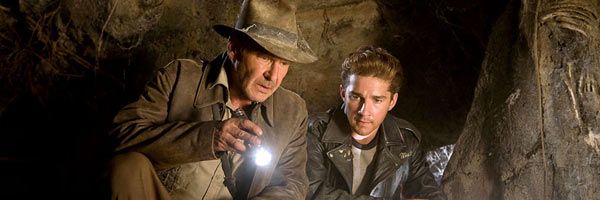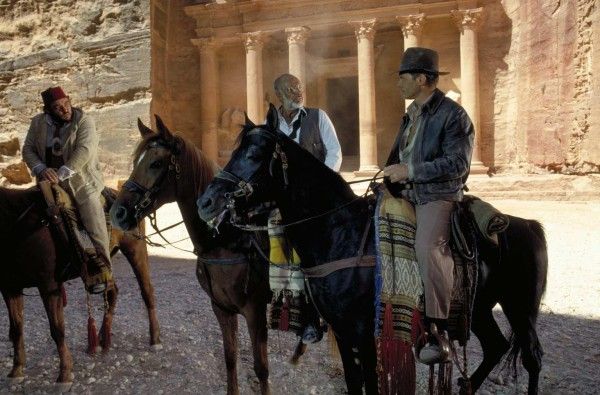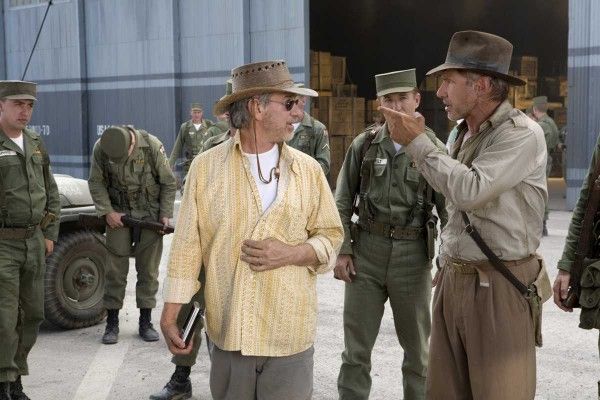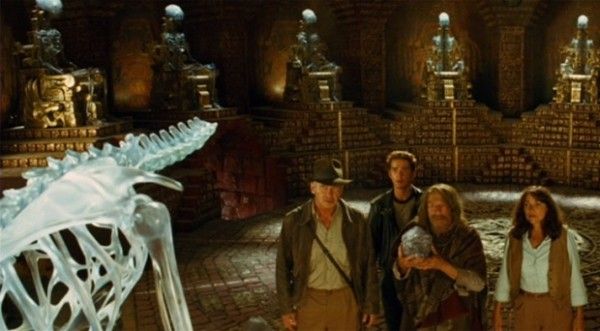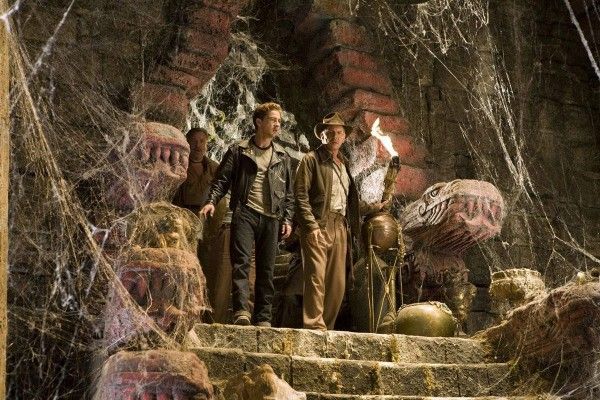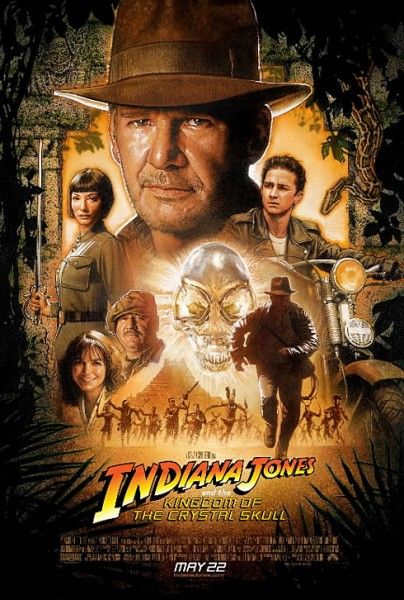The Indiana Jones franchise is one of the most beloved and long-running film franchises in history. It’s also unique in that, over the span of four films in nearly 30 years, Steven Spielberg has remained the sole director, spearheading each and every entry. With Indiana Jones 5 poised to reunite Spielberg and star Harrison Ford for a fifth time, now seemed like as good a time as any to look back at the most recent—and most controversial—installment of the franchise, and see how Indiana Jones and the Kingdom of the Crystal Skull came to be. It is a long, complicated history filled with fascinating “what if” scenarios as Spielberg, Ford, and producer George Lucas spent the better part of two decades trying to figure out what, exactly, Indiana Jones 4 would be.
1989’s trilogy-ending Indiana Jones and the Last Crusade very much feels like the final film in the franchise. It literally ends with the heroes riding off into the sunset, and while Lucas would continue the series with the TV show The Young Indiana Jones Chronicles, for all intents and purposes Last Crusade closed the book on Indy’s adult story. An entire essay could be written about the alternate versions of Last Crusade, but that’s for another day. In the context of Crystal Skull, it’s simply important to remember that with the release of the 1989 film, there was a sense of completion in the air.
And yet, when Ford came in to record a cameo for The Young Indiana Jones Chronicles in 1992, Lucas was struck with inspiration yet again—what about an Indiana Jones story set in the 1950s, drawing from the sci-fi B-movies of the era? Indeed, the entire inception of the Indiana Jones franchise came from Lucas’ love of the serials of the 1930s and 40s. When Spielberg was distraught over having been denied the opportunity to direct a James Bond movie, Lucas pitched him “something better.” That something better was Raiders of the Lost Ark, and this process of Lucas coming up with a story and Spielberg executing it would be repeated on every film in the franchise.
So with newfound inspiration for how to conceivably craft a fresh-feeling Indiana Jones 4, Lucas pitched the idea of a sci-fi-tinged sequel to Ford and Spielberg—both of whom were less than enthused. So throughout the 1990s, Lucas tasked various writers to draw up drafts of a screenplay that would find Indiana Jones confronting aliens. Jeb Stuart (The Fugitive) was the first writer involved, working on a script from 1993 to 1995 called Indiana Jones and the Saucer Men from Mars. His script would include many elements that eventually showed up in the final film: army ants, Russians as the villains, Indiana Jones pursuing a mysterious alien cylinder, and Indy getting married. In Stuart’s version, Indy married a woman named Dr. Elaine McGregor, with Karen Allen’s Marion Ravenwood only appearing via cameo during the wedding ceremony alongside Short Round, Sallah, and Henry Jones Sr.
Jeffrey Boam, who worked on Last Crusade, then came aboard to do further scriptwork, but alas Ford and especially Spielberg were still unenthused by the idea of Indiana Jones appearing side-by-side with aliens, and the release (and success) of Independence Day in 1996 was reason for everyone to pause. Moreover, Spielberg himself was working to mature as a filmmaker and wasn’t crazy about making another alien movie. It was during this time that he would make films like Schindler’s List, Amistad, and Saving Private Ryan and earn a pair of Best Director Oscars.
So work on Indiana Jones 4 hit an impasse in the mid-1990s and Lucas instead turned his focus towards the Star Wars prequels, although keeping Indiana Jones 4 on the backburner he decided to shift the focus away from an alien invasion story (to avoid comparisons to Independence Day) and move it into an “ancient civilizations” story. Then, in 2000, the stars aligned. Fans had consistently been asking Ford when the next Indiana Jones movie was happening, and he was keen on donning the fedora once again. As it just so happened, that year Ford was honored with the American Film Institute’s tribute, and at that event Ford, Lucas, Spielberg, and producers Kathleen Kennedy an Frank Marshall all reunited and began seriously talking about making Indiana Jones 4.
It was around this time that Lucas also hit upon a new idea for how to approach the whole “alien” thing, and Spielberg’s recounting of the experience on the Crystal Skull DVD bonus feature “The Return of a Legend” is gold:
“Then George came to me one day and said, ‘You know you might be right about this alien thing. Maybe we shouldn’t do aliens, there’s too much of that stuff around.’ I said, ‘George I love you, that’s the best news you’ve ever given me!’ He said, ‘Yeah they’re not aliens, they’re kind of extradimensional,’ I said, ‘What?!’ He said, ‘You ever hear of string theory, about different dimensions?’ I said, ‘Yeah’, he said, ‘Okay these are interdimensional beings. They’re not extraterrestrials, they’re interdimensional.’ So I said, ‘(Exasperated) Fine, fine! And what are they gonna look like?’ George said, ‘They’ll look like aliens, but we’ll call them interdimensional.’”
So while Spielberg’s dislike of the alien approach wasn’t entirely abandoned, it was reconfigured in a way that made him a bit more excited about the film. For a hot minute, M. Night Shyamalan—fresh off the success of The Sixth Sense—was hired to write the screenplay, but he departed the project before getting too deep into it, claiming he was overwhelmed trying to write a sequel to one of his favorite movies.
Then, in 2002, The Shawshank Redemption writer/director and eventual The Walking Dead creator Frank Darabont was hired to take a crack at the script, and his work on the film still remains one of the most famous screenplays never produced. Darabont worked for a year on the script, and while Spielberg liked it, Lucas did not. Darabont made his displeasure public:
"I spent over a year work nonstop on that, developing the script with Steven and feeling like I really had something special to live up to as a writer. So for me, it was an enormous amount of pressure to get it right. Consequently, a very interesting and disappointing experience to have Steven think I got it right and George not. But hey, as they say in The Godfather, this is the business we have chosen. Things turn out, sometimes they don't."
But Darabont’s script bares many similarities to the finished version of the film. It includes the ants, the 1950s setting, the Soviets as villains, and yes the “nuke the fridge” moment. It diverges in a couple of key ways: there’s no Mutt Williams or Mac, and joined on Indy’s adventure are Marion, Marion’s husband (a rival archaeologist), and Marion’s father Oxley.
It was reported at the time that Lucas didn’t like Darabont’s script because it painted aliens as bad guys, and indeed that’s kind of what his screenplay does. The finale—which takes place at an ancient temple, just like in Crystal Skull—finds Indy and his companions returning the skull to a skeleton, at which point an alien appears. He explains that the aliens long ago took over Earth and were mistaken by ancient civilizations as gods. As a reward for returning the skull, the alien offers to grant a wish to each of the five members of the group. However, those that wish for selfish things (like to be feared by everybody) are brutally murdered, as the alien needs their bodies to restore his own body to its former glory. Indy’s wish is to have Marion back, and for that his life is pardoned. But when he saves the life of another one of his companions, the alien becomes angry and tries to suck the life force out of Oxley. Then Indy shoots and kills the maniacal E.T.
So yeah, a rather bleak ending for extra-terrestrials as opposed to Crystal Skull, which paints the “interdimensional beings” as powerful yet just and honorable in their motives. In Darabont’s script, the giant UFO tries to take off but crashes into a giant mushroom cloud. In Crystal Skull, it flies off into the sky to parts unknown.
After Darabont’s draft, Jeff Nathanson—with whom Spielberg worked on Catch Me If You Can and The Terminal—came onboard to work on the script, and his input was so substantial he received a “story by” credit. Then, over a decade after work first began on the script, Spielberg’s Jurassic Park writer David Koepp signed on and brought it home, ultimately scoring the sole “screenplay by” credit.
The rest, as they say, is history. Indiana Jones and the Kingdom of the Crystal Skull was highly anticipated and grossed over $780 million worldwide—far more than any other installment—but while the majority of the reviews were positive, a substantial number of reviews took it to task as the worst Indiana Jones film yet. It has since worsened in reputation, but given how long and winding the development process was—and given Spielberg’s frequent reluctance to agree to direct the film—it’s something of a miracle that it even got made.

